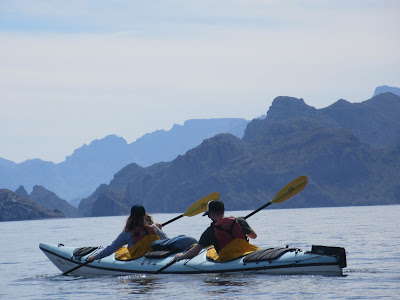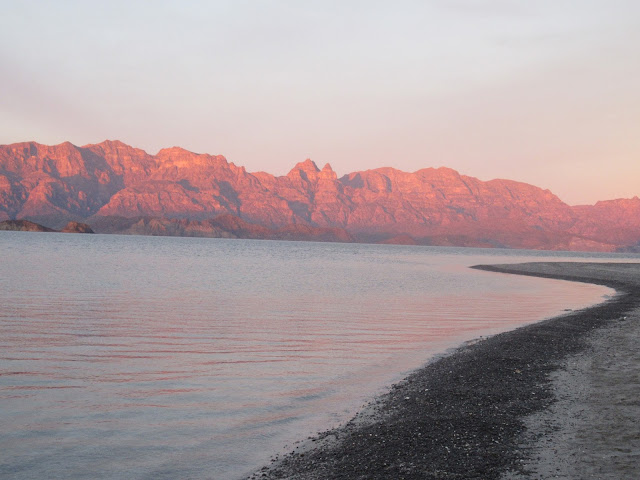Within the first few days of my arrival to
Loreto for my internship, I was off across the peninsula in the back of a
pickup. My professor and college advisor Chad Thatcher set me up with an old
student of his: Chris Garcia, who now manages operations for ROW adventures in
both Baja and Cuba. Chris was behind the wheel and the cab was occupied by his
girlfriend, Dannica and the head of operations for ROW, Geff. I was on a beach
chair nestled into gear. ROW Adventures
is an adventure company specializing in all inclusive trips around the world.
One of the aspects that sets ROW apart is their commitment to sustainability,
5% of profits are given to conservation groups in the areas that they work.
I wasn’t expecting that one of
the first things I’d get to do is go out on a tour for a night. I got an inside
look on what ROW tours are like, and what the experience feels like to be a
guest. Whale watching is the second portion of an 8 day trip that includes
three days of sea kayaking in the Sea of Cortez. Apart from the early morning chill, I was
quite comfortable. I ended up pulling out my sleeping bag to protect me from
the mountain air. The ride was beautiful and included my first sighting of a
Caracara, a scavenging bird native to Central and South America.
We made it to Puerto Lopez Mateos and hopped in an
open boat with an outboard motor and headed north in the lagoon behind Isla Magdalena. I was in the boat with
Chris, Geff, Dannica and our Pangero, boat
driver. Our initial mission was different than the tours. We were scouting for
future multi-sport camps that would include fat-tire biking, sea kayaking, bird
watching and whale watching. Sea kayaking is banned where the whale camp is due
to the large concentration of Grey Whales. Grey whales, which mainly feed in
the Arctic Ocean swim south to Baja to breed, give birth and raise their babies
before they head north. An incredible fact that I learned: Grey Whales, over
the course of their lifetimes will swim the round trip distance between the
earth and moon! We motored into the
mangroves and scared many egrets, herons, terns and Frigate Birds with our
passing. We found the approximate location and got out to take a look, our Pangero couldn´t get the engine started
when we tried to leave, so we ended up taking a longer walk across the dunes to
the Pacific and back while he worked on the outboard.
 The dune islands, Isla Magdalena and Isla de
Santo Domingo are crucial to the lagoon ecosystem. They create the protected
waters that the mangroves thrive in and the lagoons are exactly what the
whale’s need for giving birth and raising their young. The islands themselves
are home to birds, rodents, and reptiles as well as opportunistic coyotes which
have become a nuisance to the camp. The night I was there a coyote stole a
solar lamp. Most impressively, to my ears were the meadowlarks, they seemed out
of place, living on a sand island nestled between open ocean and mangrove
filled lagoons. Aside: I just took a break from writing to catch a bird, which
flew into the guide house. A whole flock birds, cuitlacoche, just descended on the guide house in their squawking
glory.
The dune islands, Isla Magdalena and Isla de
Santo Domingo are crucial to the lagoon ecosystem. They create the protected
waters that the mangroves thrive in and the lagoons are exactly what the
whale’s need for giving birth and raising their young. The islands themselves
are home to birds, rodents, and reptiles as well as opportunistic coyotes which
have become a nuisance to the camp. The night I was there a coyote stole a
solar lamp. Most impressively, to my ears were the meadowlarks, they seemed out
of place, living on a sand island nestled between open ocean and mangrove
filled lagoons. Aside: I just took a break from writing to catch a bird, which
flew into the guide house. A whole flock birds, cuitlacoche, just descended on the guide house in their squawking
glory.
The whale watching excursions via boat were
magnificent. The pangeros have been
educated in how to approach whales and follow rules dictating the number of
boats to a whale, two, as well as how close they are allowed to get to the
whales, 10 meters. I have seen grey whales off the coast in Oregon, they stick
close to shore on their migration to and from the Arctic. But I have never seen
a whale so close. The most impressive part was the deep rumble as they exhale
from their blow holes. The lagoon is filled with whales, it took us little
searching to find a mother whale and her calf. We followed them closely for an
hour while the mother guided her calf. The lagoon offers not only protection
from the open ocean but a great training ground where the babies can train
swimming against the tidal currents. As the calf matures and its curiosity
grows they will come right up to the boat and will let themselves be touched.
This happens in late February and into March before they head north.

The best time to view whales is at dawn. They
are especially active and I got to see them “spy hopping,” which are the whales
raising their heads fully out of the water to peek at the world above the waves.
The camp is perfectly situated right in front of a main channel in and out of
the lagoons. My favorite moment of the tour was watching the whales pass by
camp as the sun rose.
 The second whale watching tour that I went on
included sightings of both coyotes and bottle-nosed dolphins. We traveled more and
got to hangout with a few different whales. Each whale can be distinguished by
their barnacles, Grey Whales are hosts to many different species of marine
hitchhikers, biologist’s use the size and shape of barnacles to identify
individual whales. Grey whales have no dorsal fins instead they have 6 “knuckles”
on their backs. These bumps add to their prehistoric allure. Never having been
so close to a whale, the monumental sound of their exhalation as their bodies
slid through the water was jaw dropping. The patches of barnacles and knuckles
added to the feeling that I was looking at a prehistoric beast. In fact, grey
whales are considered one of the oldest species of whales found today and are
the only species in their genus and family. On our way back to camp we came
across a pod of dolphins, about eight individuals including one baby. The pangero swung the boat around and we
played a game of tag with the dolphins for about 10 minutes.
The second whale watching tour that I went on
included sightings of both coyotes and bottle-nosed dolphins. We traveled more and
got to hangout with a few different whales. Each whale can be distinguished by
their barnacles, Grey Whales are hosts to many different species of marine
hitchhikers, biologist’s use the size and shape of barnacles to identify
individual whales. Grey whales have no dorsal fins instead they have 6 “knuckles”
on their backs. These bumps add to their prehistoric allure. Never having been
so close to a whale, the monumental sound of their exhalation as their bodies
slid through the water was jaw dropping. The patches of barnacles and knuckles
added to the feeling that I was looking at a prehistoric beast. In fact, grey
whales are considered one of the oldest species of whales found today and are
the only species in their genus and family. On our way back to camp we came
across a pod of dolphins, about eight individuals including one baby. The pangero swung the boat around and we
played a game of tag with the dolphins for about 10 minutes.

I left soon after with Chris, Dannika and Geff
while the guests stayed on for another day of whale filled adventures. I thoroughly
enjoyed my short stay at the whale camp and am grateful for getting such a good view of the workings of a ROW tour.








